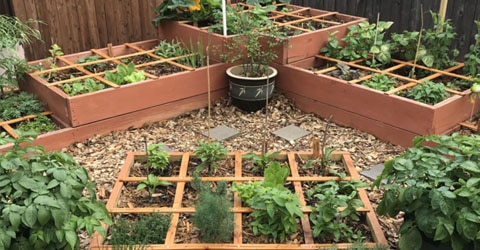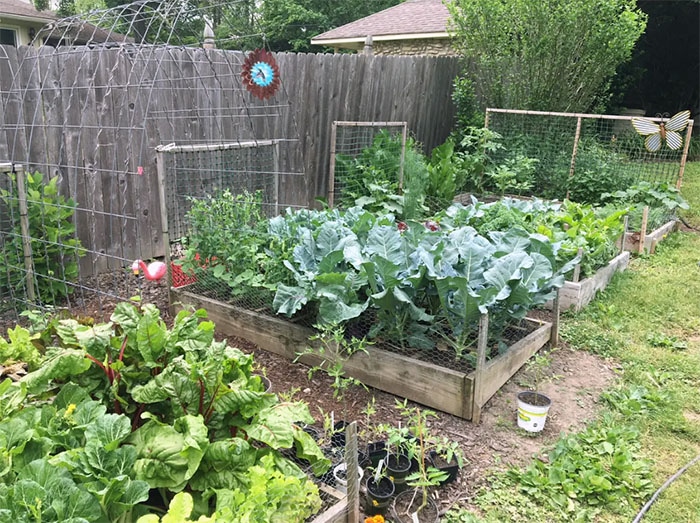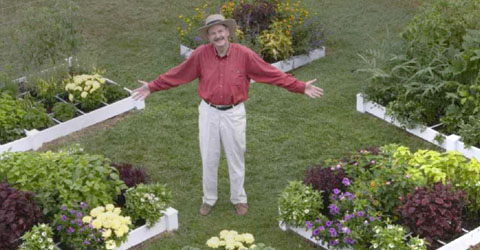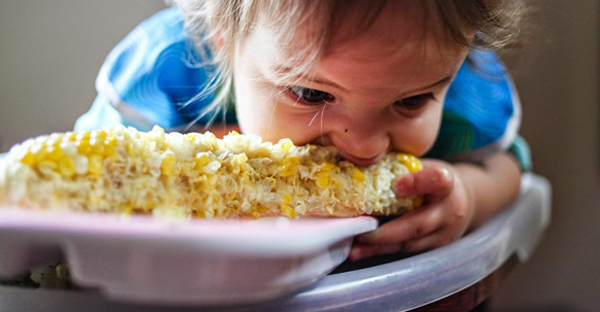

Learn the easiest, most productive method of gardening without the weeds, work, and waste of a traditional row garden! The Square Foot Gardening (SFG) Method was created by Mel Bartholomew as an alternative to row gardening. This condensed method of gardening uses less water, soil, space, and fewer tools. Reducing, reusing, and recycling are big themes in the SFG Method! This Info Sheet can help you create a Square Foot Garden in your backyard, on a rooftop or balcony, in a parking lot, or in a community garden. Utilizing Mel’s Mix – a special growing soil that you can make yourself – and a grid for plant-spacing, it’s easy to maintain and it’s perfect for beginners. For more detailed information, it is recommended that you purchase a copy of the All New Square Foot Gardening Third Edition book, or borrow it from your local library. Here is an overview of the basics and benefits!
The 10 Basics:
1. Plant densely. Don’t waste space. You can grow a lot of produce in much less space that you dreamed possible. A huge row garden just isn’t necessary—placing a few Square Foot Garden beds in a relatively small space can be more productive than a large row garden that occupies a good portion of your yard.
2. Grow up. The greatest productivity comes by growing up, not out. A variety of easy-to-build trellis structures allow vining vegetables to use the vertical plane rather than sprawling out as they do in a traditional row garden.
3. Mel’s Mix, not garden soil. You don’t need your old garden soil to grow great vegetables. The best results come if you make your own growing medium—the fabulous formula Mel Bartholomew created, which we call Mel’s Mix.
4. Garden close to your home. Gardens are more efficient when planted close to your house, not in a distant plot. It’s human nature to pay attention to what is close-at-hand, and Square Foot Gardens should be close to your house where you can admire them and tend them easily.
5. Grow shallow. Raised beds don’t have to be large and deep: a mere 6 inches of growing medium is all it takes for most crops. Gone are the days of laboriously digging and double-digging a row garden to mix in soil amendments to improve the soil.
6. Fertilizer is not needed. Mel’s Mix has a rich mixture of different organic composts, and provides all the nutrients that plants need. Just add fresh compost when you replant a square.
7. Keep aisles between boxes narrow. Rather than long rows, a vegetable garden is most efficient planted in small boxes with aisles set about 3 feet apart. The traditional practice of planting long rows with wide, empty spaces between them just creates more ground in which weeds can grow. That’s too much work!
8. Be stingy with seeds. Rather than planting lots of seeds, then thinning them out to the desired spacing, SFG uses a simple 1,4,9,16 spacing guideline. No wasting seeds or thinning. Seeds can last for two or more growing seasons when stored properly.
9. Plant in squares. Planting in 1-foot squares is the most efficient way to plant. Mel viewed this as one of the very important basics of his method. The grids are key to planting efficiently and rotating in new crops when the first crop has produced its bounty. And by planting with diversity—many different types of plants intermingled in a single box—you eliminate many of the disease problems that can plague a traditional garden.
10. Rotate crops. Rotation planting is automatic in a SFG and gives the maximum yield from your garden. The yield from a single 4 ×4-foot SFG will surprise you, and the reason is that many of the squares can be planted at least twice in a gardening season—either with two successive crops of the same vegetable or swapping out a new crop for late-season produce.
In practice, these 10 principles of Square Foot Gardening become the core by which you can garden with remarkable efficiency. The first steps can be done well before the growing season starts—and don’t we all like to dream and plan during the late-winter and early spring months, when we are just itching to get out in the garden again?
Square Foot Gardening is Earth Friendly. Some of the benefits include:
• Reduce: The SFG Method eliminates waste, minimizes the need to buy fresh produce in grocery stores (lowering transportation expenses and household costs), and uses less water.
• Reuse: Build your square foot garden box out of scrap lumber, old decking, or even cement blocks. Re-plant your squares after harvesting, and even regrow new plants from kitchen scraps.
• Recycle: Food scraps can be composted!
• Eliminates waste: Only plant the amount of food you need, don’t use more soil than you need, and use just enough water for plants to grow. You can grow twice as much produce in half the space of a traditional row garden.
• Community and family gardening: The SFG Method is a perfect way to create a community garden from which many can benefit, or get the whole family involved! Kids love to garden, and SFG is a great way to help them on their plant-based journey! This method is easy for young, old, and beginner gardeners.

The 8 Steps of Building your Square Foot Garden – This is meant to be an overview. For details, we recommend using the book as a guide.
1. Plan your garden – Create a map of your garden by drawing a big square with 16 squares inside. Use a pencil as you may want to adjust your planning. If you have the All New Square Foot Gardening Method Third Edition book handy, refer to chapter 3 to learn how to plan your boxes to grow the amount of produce you’re likely to need. Tip: put plants that will grow the tallest on the North side of the box and plants that require more attention such as bush beans near the borders of the box.
2. Lay out the garden – A sunny location close to the house is the best spot. Use chapter 4 to plan the shape and configuration of the SFG boxes and map out where they will be located in your yard/area.
3. Build boxes and grids – A simple 4’ x 4’ box is the recommended layout for beginners. If you choose to do another configuration, just make sure you can walk all the way around your box and be able to reach into each square. Grids allow for visualization for planting and help prevent overplanting. Grids also maximize the harvest. Chapter 5 provides instructions about how to build the basic 4’ x 4’ box that is six inches deep, as well as other box shapes and sizes.
4. Build box accessories – Consider building trellises to get the most use of space, protective covers for pest and critter protection, or other accessories for maximum productivity and efficiency.
5. Create Mel’s Mix (see #3 in “The 10 Basics” section) – One of the most important factors in SFG is creating a special growing medium. To make Mel’s Mix you will need a large tarp, particle mask for dust, shovel or rake, compost, coarse vermiculite, peat moss, wheelbarrow, and a water supply. Spread out tarp, empty the measured compost onto it, then add peat moss and mist lightly with hose. Add the coarse vermiculite and mix well. Transfer mix to the garden box, water thoroughly, and add your grid. It is recommended to follow the book for best results and chapter 7 explains the importance of using this mix.
6. Plant – Chapter 8 provides details about how to plant with no wasted seeds. If you decide not to use seeds, you can start your garden with “plant starts”. These are the plants already started in cell packs that you find in your local nursery or garden centers. Divide your squares into either 1, 4, 9, or 16 holes for seeds/plants. Determine the number by thinking of the grown plant in sizes of small, medium, large and extra large. Use your fingers to evenly divide 1×1-foot squares into appropriate number of holes, depending on the crops.
• 1 per square for extra-large crops such as broccoli, cabbage, and peppers
• 4 per square for large crops such as a lead lettuce, swiss chard, or even flowers
• 9 per square for medium crops such as bush beans, spinach, or beets
• 16 per square for small crops such as carrots, radishes, or onions
7. Maintain – In chapter 9 you’ll learn techniques for watering and weeding your garden, as well as inspecting it and tending to any pest problems and diseases. Some tips include: hand water at base of plant. Avoid sprinklers! Overhead watering is wasteful and causes disease. Hand pick pests or cut away infected plant parts with scissors. Wash scissors afterwards. Clean up any dead debris around plants. Vertical crops – weave in and out of netting weekly being careful not to break.
8. Harvest – With careful planning, your garden will have a good, long harvest season. Given the diverse planting pattern of a square foot garden, this pleasure occurs all through the gardening season and beyond. Chapter 10 will help guide you with timing your harvest, harvesting techniques and storing your harvest.

Thank you to the Square Foot Gardening Foundation for creating the original content and PowerPoint Presentation that this article was adapted from.
*This article is reprinted with permission from plantpurecommunities.org. Read more tips in their Gardening Toolkit.
Copyright 2025 Center for Nutrition Studies. All rights reserved.
Deepen Your Knowledge With Our
Plant-Based Nutrition
Certificate
Plant-Based Nutrition Certificate
- 23,000+ students
- 100% online, learn at your own pace
- No prerequisites
- Continuing education credits







